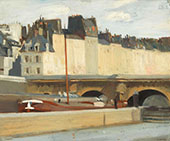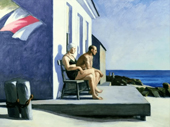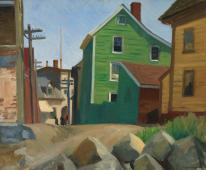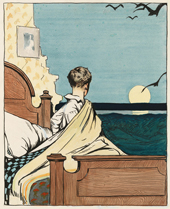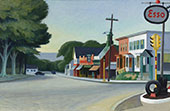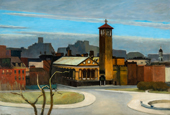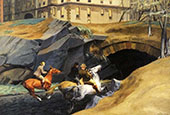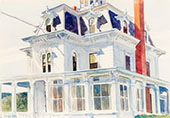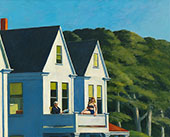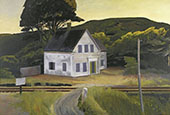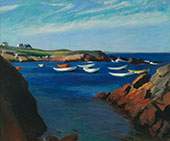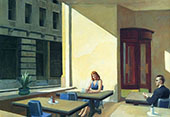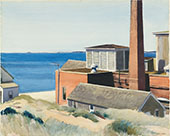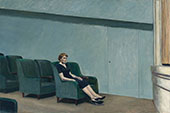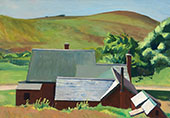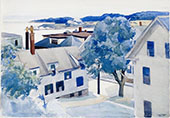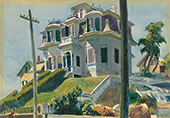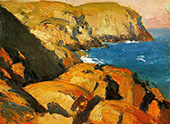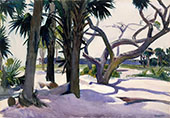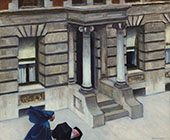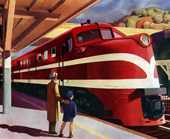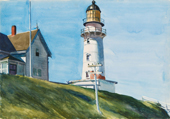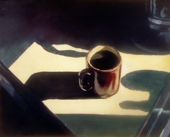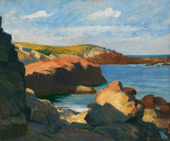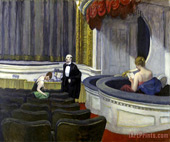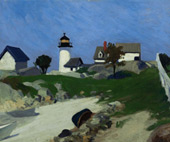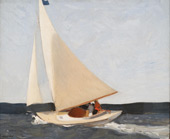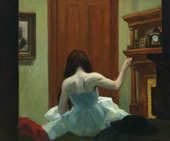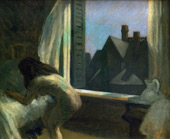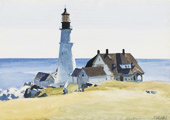Edward Hopper Oil Painting Reproductions
Edward Hopper replica paintings on Canvas for sale
Edward Hopper Paintings: An Artistic Biography
Born on 22 July 1882, Edward Hopper was an American realist painter.
Spending his youth in the leafy suburb of Nyack, New York, Hopper’s family was well-off. His boyhood home in the area still serves as the Edward Hopper House Art Center.
Edward attended both private and public schools alongside his sister, Marion. His father had strong Baptist faith and a mild manner. Women often led the household, including Hopper’s grandmother, mother, sister, and the family house cleaner.
Hopper proved his artistic talent from an early age. His drawing developed from age five, and the young boy loved studying French and Russian history and culture. Supported by his parents with books, magazines, and illustrations, Hopper produced many early charcoal sketches. Yet, even in these childhood drawings, his careful observations of light and shadow are precise.
What is Edward Hopper most known for?
Edward Hopper is best known for his realist oil paintings. His first signed artwork came in 1895 (at the age of thirteen), with Rowboat in Rocky Cove. Many of his teenage works copied illustrations the young man saw in magazines and journals.
Hopper’s parents insisted his studies focus on commercial art after graduating from school. He started with a “correspondence” course but quickly transferred to fine arts. Attending the New York School of Art and Design (under teachers such as William Merritt Chase and Robert Henri), he honed his oil painting technique.
Hopper’s early paintings are known for emulating Chase and French Impressionist artists such as Edgar Degas and Edouard Manet. However, he took Henri’s advice to heart that it wasn’t the “subject” that counted in art but “what you feel about it.” Hopper consequently imbued his work with a modern spirit, explaining his frequent use of contemporary interiors and isolated characters.
What painting made Edward Hopper famous?
Edward Hopper Automat at Night (painted 1927) made the artist’s name. After completing his education, Hopper worked in illustration for an advertising agency. He hated the work, however, escaping whenever possible with trips to Paris.
Despite these frequent trips to the epicenter of French creativity, Hopper appeared unfazed by avant-garde developments such as Cubism. He hadn’t heard of Picasso but described Rembrandt’s The Night Watch as “the most wonderful thing” he ever saw.
The young man returned to New York, working as a freelance illustrator struggling to make ends meet. Despite exhibiting in several exhibitions (including The Independents exhibition in 1912 and the Armory Show in 1913), his works didn’t attract much attention. In the early 1920s, however, Hopper’s etchings gained increasing public recognition.
He married Josephine Nivison (a fellow artist) in 1924. She was pivotal to Hopper’s career, helping secure prominent exhibitions and a steady stream of sales. She also modeled many Edward Hopper paintings.
Josephine also appears in Automat, shown at the opening of Hopper’s second solo show in February 1927 at Rehn Galleries in New York. Sold for the hefty sum of $1,200 (around $19,000 today), it made Hopper’s name.
Why is Edward Hopper so important?
Edward Hopper is important for his famous oil paintings, created in a soft realist style. Uniquely presenting the ambiguities and loneliness of a large city, they are still as relevant today as in the early twentieth century.
After the success of Automat, Hopper continued depicting modern commercial settings. Then, two years later, he painted Chop Suey (1929). This painting was another contemporary masterpiece, set in a New York Chinese restaurant.
The same year, Stephen Clark (a famed art patron) donated Hopper’s House by the Railroad (1925) to the Museum of Modern Art. Again, the painting cemented Hopper’s reputation and saw other leading museums (such as the Metropolitan Museum of Art and the Whitney Museum of American Art) follow suit.
The Hoppers rented a cottage on Cape Cod in 1930. They returned to the picturesque spot yearly, also holidaying in South Royalton, Vermont.
These two rural locations inspired many later Edward Hopper paintings. These works are unusual amongst his oeuvre for their purity and brightness. They often featured vivid, bold landscapes such as Corn Hill, Truro, and Cape Cod (1930).
What is Edward Hopper's most famous painting?
If there’s one most famous Edward Hopper painting, it must be Nighthawks (1942).
Edward Hopper Nighthawks is still his most recognizable painting to this day. Depicting the alienation of modern life in twentieth-century America, it’s a haunting image. Figures sit silently around a bar in a sickly yellow room under fluorescent light. The large window lets viewers watch the bar’s inhabitants like fish in a tank, all lost in their thoughts and emotions.
Set in New York, Hopper claimed the painting responded to Ernest Hemingway’s short stories. The artist aimed to communicate these universal human emotions by discussing themes of death, life, and loneliness.
Like all his paintings, Nighthawks by Edward Hopper is meticulously detailed. He worked on the painting for over two months, detailing his decisions in a personal diary. We also know his wife Jo, modeled as the woman in the painting. Luckily, all this arduous work paid off, and the artwork sold for $3,000 (almost $50,000 today) on its first display at Rehn’s Gallery.
Hopper was incredibly productive during the late 1930s and early 1940s. As well as Nighthawks, he painted iconic works such as New York Movie Theater (1939) and Hotel Lobby (1943) during this time.
What techniques did Edward Hopper use?
Edward Hopper art used techniques honed during his early career as an illustrator. As a result, he produced many distinguished watercolor paintings and skillful pencil sketches and etchings.
In terms of fine art oil painting, though, Hopper often focused on geometric architectural design. He carefully placed figures amongst almost theatrical sets. Hopper worked slowly and methodically, building up vivid colors over prolonged periods.
He worked out compositions with many preparatory sketches, often discussing his paintings in letters with his wife and friends. For instance, Hopper planned New York Movie Theatre with over 53 sketches.
In addition to this precise planning, Hopper’s careful observation of light and shadow was an essential technique. In a symbolist manner, bright sunlight imbues psychological insight. On the contrary, dark shadows (for instance, in Cup of Coffee, 1955) play similarly important roles. They often emphasize feelings of uncertainty, anxiety, and modern weariness.
What kind of artist was Edward Hopper?
Edward Hopper was a profoundly thoughtful and meticulous artist. His art created intense drama from everyday scenes, with carefully controlled compositions and intellectual themes.
Despite his astounding productivity in the late 1930s and early 1940s, Hopper suffered from inertia and inactivity towards the decade’s end. Hopper said of his struggles, “I wish I could paint more.” In addition, his health gradually failed from this point onwards, with several prostate surgeries and medical issues.
Despite these tribulations, Hopper created some significant works during the 1950s and 1960s. Oil paintings from this period include Hotel by a Railroad (1952), which reference his earlier House by a Railroad (1925). Sun in an Empty Room (1963) continues Hopper’s fascination with light and windows.
The theater-scene Intermission (painted in 1966) was one of Hopper’s last, characteristically enigmatic oil paintings.
What do Edward Hopper's paintings mean?
Edward Hopper paintings are notoriously elusive. Frequently reluctant to discuss his artwork, Hopper once elusively claimed all the answers were “there on the canvas.” However, he also claimed (in 1953) that great art was the “outward expression of an inner life” of artists.
Nonetheless, Hopper often veered towards symbolism, an artistic movement aiming to communicate “absolute truths” metaphorically. Deeply influenced by Sigmund Freud’s new psychoanalytical theories, Hopper described his art as “an expression of the subconscious.”
While Hopper’s silent interiors and vague encounters often suggest melancholy, he never dictates the viewer’s “proper” emotional response. Instead, as described by one critic, Edward Hopper art got the “quality of America” onto his canvases.
Hopper died in his New York studio on 15 May 1967. Buried in a cemetery at Nyack, Hopper’s wife (Jo Hopper) also died just ten months later.
How many paintings did Edward Hopper make?
While Edward Hopper is best known for his oil paintings, he also created watercolors and etchings. As a result, Hopper created over 800 works in his lifetime. Around 360 of these creations were paintings.
While this may seem significant, many art historians don’t consider Hopper a “prolific artist.” Indeed, his techniques were incredibly time-consuming. Furthermore, Hopper often spoke of problems producing ideas. He often drew several drafts in his journals, playing with poses and compositions before even thinking about painting.
Furthermore, Hopper’s output declined later in life. He only created around five paintings a year during his seventies.
Edward hopper painting: Fine art reproductions
If you love the ambiguous beauty and intense realism of Edward Hopper paintings, explore our extensive collection of his art. As well as famous works such as Nighthawks by Edward Hopper, you’ll find fine art oil paintings throughout his pioneering career.
Cannot Find What You Are Looking For?
Reproduction Gallery Information
Customer Service
(Send Us A Message)
Tel: (503) 937 2010
Fax: (503) 937 2011


